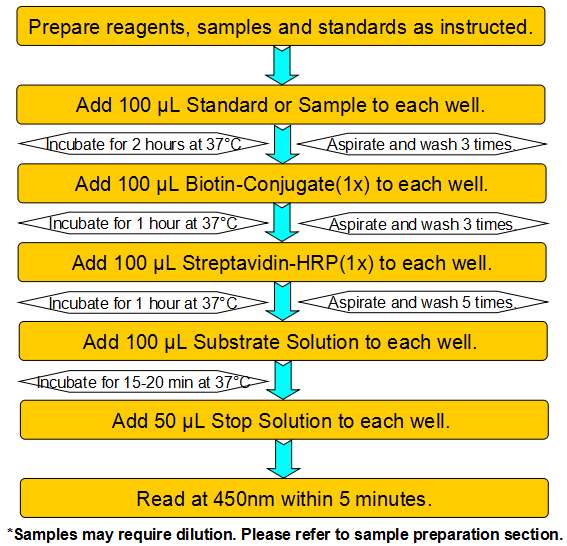Product Details
| Species Reactivity |
Mouse (Mus musculus) |
| UniProt |
|
| Abbreviation |
INS |
| Alternative Names |
ILPR; IRDN; OTTHUMP00000011162|OTTHUMP00000196038|proinsulin |
| Range |
3.12-200 nIU/mL |
| Sensitivity |
1.04 nIU/mL |
| Sample Type |
Serum, Plasma, Other biological fluids |
| Detection Method |
Sandwich |
| Analysis Method |
Quantitive |
| Assay Duration |
1-4.5h |
| Sample Volume |
1-200 μL |
| Detection Wavelengt |
450 nm |
Test principle
This assay employs a two-site sandwich ELISA to quantitate INS in samples. An antibody specific for INS has been pre-coated onto a microplate. Standards and samples are pipetted into the wells and any INS present is bound by the immobilized antibody. After removing any unbound substances, a biotin-conjugated antibody specific for INS is added to the wells. After washing, Streptavidin conjugated Horseradish Peroxidase (HRP) is added to the wells. Following a wash to remove any unbound avidin-enzyme reagent, a substrate solution is added to the wells and color develops in proportion to the amount of INS bound in the initial step. The color development is stopped and the intensity of the color is measured.
Product Overview
Insulin is a polypeptide hormone originating in the beta cells of the pancreas and serving as a principal regulator for the storage and production of carbohydrates. Its secretion is normally stimulated by increases in the amount of glucose in circulation. This leads to higher insulin levels and more rapid tissueassimilation of glucose followed by a decline in the insulin level as the glucose level subsides. In a number of conditions, notably insulinoma and diabetes, this relationship is impaired. Insulin tends to circulate at inappropriately high levels in patients with insulin-secreting pancreatic tumors; such tumors can thus be a cause of hypoglycemia. Accordingly, insulin immunoassays used sometimes in connection with provocative doses of tolbutamide or calcium play an essential role in the identification (and localization) of insulinomas.
Components
Reagents |
Quantity |
Reagents |
Quantity |
Assay plate (96 Wells) |
1 |
Instruction manual |
1 |
Standard (lyophilized) |
2 |
Sample Diluent |
1 x 20 mL |
Biotin-Conjugate (concentrate 100 x) |
1 x 120 μL |
Biotin-Conjugate Diluent |
1 x 12 mL |
Streptavidin-HRP (concentrate 100 x) |
1 x 120 μL |
Streptavidin-HRP Diluent |
1 x 12 mL |
Wash Buffer (concentrate 25 x) |
1 x 20 mL |
Substrate Solution |
1 x 10 mL |
Stop Solution |
1 x 6 mL |
Adhesive Films |
4 |
Specificity
This assay has high sensitivity and excellent specificity for detection of Mouse INS. No significant cross-reactivity or interference between Mouse INS and analogues was observed.
Recovery
Matrices listed below were spiked with certain level of recombinant Mouse INS and the recovery rates were calculated by comparing the measured value to the expected amount of Mouse INS in samples.
Precision
Intra-assay Precision (Precision within an assay)
Three samples of known concentration were tested twenty times on one plate to assess intra-assay precision.
Inter-assay Precision (Precision between assays)
Three samples of known concentration were tested in forty separate assays to assess inter-assay precision.
CV (%) = SD/meanX100
Intra-Assay: CV<8%
Inter-Assay: CV<12%
Linearity
The linearity of the kit was assayed by testing samples spiked with appropriate concentration of Mouse INS and their serial dilutions. The results were demonstrated by the percentage of calculated concentration to the expected.
Stability
The stability of ELISA kit is determined by the loss rate of activity. The loss rate of this kit is less than 5% within the expiration date under appropriate storage condition.
The loss rate was determined by accelerated thermal degradation test. Keep the kit at 37°C for 4 and 7 days, and compare O.D.values of the kit kept at 37°C with that of at recommended temperature. (referring from China Biological Products Standard, which was calculated by the Arrhenius equation. For ELISA kit, 4 days storage at 37°C can be considered as 6 months at 2 - 8°C, which means 7 days at 37°C equaling 12 months at 2 - 8°C).
Sample collection and storage
Serum: Use a serum separator tube (SST) and allow samples to clot for two hours at room temperature or overnight at 2 - 8°C before centrifugation for 15 minutes at 1000 × g. Remove serum and assay immediately or aliquot and store samples at ≤ -20°C. Avoid repeated freeze-thaw cycles.
Plasma: Collect plasma using EDTA, or heparin as an anticoagulant. Centrifuge for 15 minutes at 1000 × g at 2 - 8°C within 30 minutes of collection. Assay immediately or aliquot and store samples at ≤ -20°C. Avoid repeated freeze-thaw cycles.
Other biological fluids: Centrifuge samples for 20 minutes at 1000 × g. Remove particulates and assay immediately or store samples in aliquot at -20°C or -80°C. Avoid repeated freeze/thaw cycles.
Kits storage instructions
Store at 2-8°C. Please refer to Instruction Manual.



